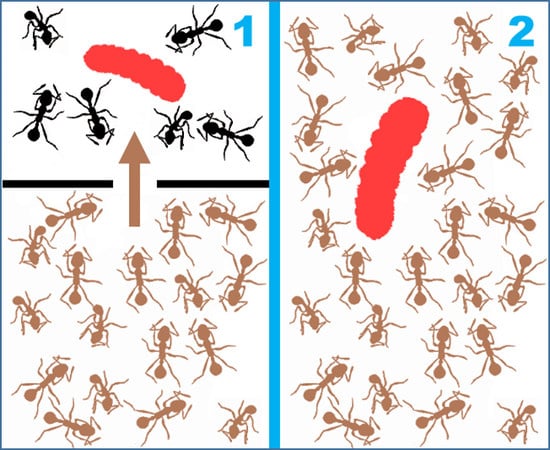Host Ant Change of a Socially Parasitic Butterfly (Phengaris alcon) through Host Nest Take-Over
Simple Summary
Abstract
1. Introduction
2. Materials and Methods
2.1. Study Species, Population and Site
2.2. Collecting and Culturing
2.3. Tests of Colony Take-Over
2.3.1. “Vacant Possession” Test
2.3.2. “Takeover” Test
2.4. Data Analysis
2.4.1. Ant Outcomes
2.4.2. Caterpillar Survivorship
3. Results
3.1. Ant Outcomes
3.2. Caterpillar Survivorship
4. Discussion
5. Conclusions
Author Contributions
Funding
Acknowledgments
Conflicts of Interest
Appendix A
| Nurse Colony | “Foreign” Colony | Experimental Nest ID | |||
|---|---|---|---|---|---|
| Colony ID | Site | Colony ID | Myrmica Species | “Vacant Possession” | “Takeover” |
| B01 | Bükkszentkereszt | K13 | scabrinodis | B01-1 | B01-2 |
| B02 | Bükkszentkereszt | K06 | scabrinodis | B02-1 | B02-2 |
| B03 | Bükkszentkereszt | K02 | scabrinodis | B03-1 | B03-2 |
| B03 | Bükkszentkereszt | K07 | scabrinodis | B03-3 | B03-4 |
| B04 | Bükkszentkereszt | K09 | scabrinodis | B04-1 | B04-2 |
| B04 | Bükkszentkereszt | B13 | scabrinodis | B04-3 | B04-4 |
| B05 | Bükkszentkereszt | K12 | scabrinodis | B05-1 | B05-2 |
| B07 | Bükkszentkereszt | K09 | scabrinodis | B07-1 | B07-2 |
| B08 | Bükkszentkereszt | K11 | scabrinodis | B08-1 | B08-2 |
| B08 | Bükkszentkereszt | B13 | scabrinodis | B08-3 | B08-4 |
| B09 | Bükkszentkereszt | K11 | scabrinodis | B09-1 | B09-2 |
| B10 | Bükkszentkereszt | K06 | scabrinodis | B10-1 | B10-2 |
| B11 | Bükkszentkereszt | K08 | scabrinodis | B11-1 | B11-2 |
| B11 | Bükkszentkereszt | K08 | scabrinodis | B11-3 | B11-4 |
| B12 | Bükkszentkereszt | K04 | scabrinodis | B12-1 | B12-2 |
| B12 | Bükkszentkereszt | K12 | scabrinodis | B12-3 | B12-4 |
| B13 | Bükkszentkereszt | B08 | sabuleti | B13-1 | B13-2 |
| B13 | Bükkszentkereszt | B04 | sabuleti | B13-3 | B13-4 |
| K01 | Kecskeláb-rét | K03 | sabuleti | K01-1 | K01-2 |
| K02 | Kecskeláb-rét | B03 | sabuleti | K02-1 | K02-2 |
| K02 | Kecskeláb-rét | K03 | sabuleti | K02-3 | K02-4 |
| K03 | Kecskeláb-rét | K02 | scabrinodis | K03-1 | K03-2 |
| K03 | Kecskeláb-rét | K01 | scabrinodis | K03-3 | K03-4 |
| K04 | Kecskeláb-rét | B12 | sabuleti | K04-1 | K04-2 |
| K05 | Kecskeláb-rét | K10 | sabuleti | K05-1 | K05-2 |
| K06 | Kecskeláb-rét | B02 | sabuleti | K06-1 | K06-2 |
| K06 | Kecskeláb-rét | B10 | sabuleti | K06-3 | K06-4 |
| K07 | Kecskeláb-rét | K10 | sabuleti | K07-1 | K07-2 |
| K07 | Kecskeláb-rét | B03 | sabuleti | K07-3 | K07-4 |
| K08 | Kecskeláb-rét | B11 | sabuleti | K08-1 | K08-2 |
| K08 | Kecskeláb-rét | B11 | sabuleti | K08-3 | K08-4 |
| K09 | Kecskeláb-rét | B07 | sabuleti | K09-1 | K09-2 |
| K09 | Kecskeláb-rét | B04 | sabuleti | K09-3 | K09-4 |
| K10 | Kecskeláb-rét | K05 | scabrinodis | K10-1 | K10-2 |
| K10 | Kecskeláb-rét | K07 | scabrinodis | K10-3 | K10-4 |
| K11 | Kecskeláb-rét | B08 | sabuleti | K11-1 | K11-2 |
| K11 | Kecskeláb-rét | B09 | sabuleti | K11-3 | K11-4 |
| K12 | Kecskeláb-rét | B05 | sabuleti | K12-1 | K12-2 |
| K12 | Kecskeláb-rét | B12 | sabuleti | K12-3 | K12-4 |
| K13 | Kecskeláb-rét | B01 | sabuleti | K13-1 | K13-2 |
References
- Schmid-Hempel, P. Parasites and their social hosts. Trends Parasitol. 2017, 33, 453–462. [Google Scholar] [CrossRef] [PubMed]
- Hölldobler, B.E.; Wilson, E.O. The Ants; The Belknap Press of Harvard University Press: Cambridge, MA, USA, 1990. [Google Scholar]
- Witek, M.; Barbero, F.; Markó, B. Myrmica ants host highly diverse parasitic communities: From social parasites to microbes. Insectes Soc. 2014, 61, 307–323. [Google Scholar] [CrossRef]
- Tartally, A.; Thomas, J.A.; Anton, C.; Balletto, E.; Barbero, F.; Bonelli, S.; Bräu, M.; Casacci, L.P.; Csősz, S.; Czekes, Z.; et al. Patterns of host use by brood parasitic Maculinea butterflies across Europe. Philos. Trans. R. Soc. B Biol. Sci. 2019, 374, 20180202. [Google Scholar] [CrossRef] [PubMed]
- Nash, D.R.; Als, T.D.; Maile, R.; Jones, G.R.; Boomsma, J.J. A mosaic of chemical coevolution in a large blue butterfly. Science 2008, 319, 88–90. [Google Scholar] [CrossRef] [PubMed]
- Schlick-Steiner, B.C.; Steiner, F.M.; Höttinger, H.; Nikiforov, A.; Mistrik, R.; Schafellner, C.; Baier, P.; Christian, E. A butterfly’s chemical key to various ant forts: Intersection-odour or aggregate-odour multi-host mimicry? Naturwissenschaften 2004, 91, 209–214. [Google Scholar] [CrossRef] [PubMed]
- Schönrogge, K.; Wardlaw, J.C.; Peters, A.J.; Everett, S.; Thomas, J.A.; Elmes, G.W. Changes in Chemical Signature and Host Specificity from Larval Retrieval to Full Social Integration in the Myrmecophilous Butterfly Maculinea Rebeli. J. Chem. Ecol. 2004, 30, 91–107. [Google Scholar] [CrossRef] [PubMed]
- Thomas, J.A.; Settele, J. Butterfly mimics of ants. Nature 2004, 432, 283–284. [Google Scholar] [CrossRef]
- Barbero, F.; Thomas, J.A.; Bonelli, S.; Balletto, E.; Schönrogge, K. Queen ants make distinctive sounds that are mimicked by a butterfly social parasite. Science 2009, 323, 782–785. [Google Scholar] [CrossRef]
- Thomas, J.A.; Elmes, G.W.; Wardlaw, J.C.; Woyciechowski, M. Host specificity among Maculinea butterflies in Myrmica ant nests. Oecologia 1989, 79, 452–457. [Google Scholar] [CrossRef]
- Thomas, J.A.; Elmes, G.W. Higher productivity at the cost of increased host-specificity when Maculinea butterfly larvae exploit ant colonies through trophallaxis rather than by predation. Ecol. Entomol. 1998, 23, 457–464. [Google Scholar] [CrossRef]
- Thomas, J.A.; Elmes, G.W.; Sielezniew, M.; Stankiewicz-Fiedurek, A.; Simcox, D.J.; Settele, J.; Schönrogge, K. Mimetic host shifts in an endangered social parasite of ants. Proc. R. Soc. B Biol. Sci. 2013, 280, 20122336. [Google Scholar] [CrossRef] [PubMed]
- Thomas, J.A.; Elmes, G.W.W.; Schönrogge, K.; Simcox, D.J.J.; Settele, J. Primary hosts, secondary hosts and ‘non-hosts’: Common confusions in the interpretation of host specificity in Maculinea butterflies and other social parasites of ants. In Studies on the Ecology and Conservation of Butterflies in Europe; Settele, J., Kühn, E., Thomas, J.A., Eds.; Pensoft: Sofia, Bulgaria, 2005; Volume 2, pp. 99–104. [Google Scholar]
- Thomas, J.A.; Wardlaw, J.C. The capacity of a Myrmica ant nest to support a predacious species of Maculinea butterfly. Oecologia 1992, 91, 101–109. [Google Scholar] [CrossRef] [PubMed]
- Tartally, A.; Koschuh, A.; Varga, Z. The re-discovered Maculinea rebeli (Hirschke, 1904): Host ant usage, parasitoid and initial food plant around the type locality with taxonomical aspects (Lepidoptera, Lycaenidae). Zookeys 2014, 406, 25–40. [Google Scholar] [CrossRef] [PubMed]
- Bereczki, J.; Pecsenye, K.; Varga, Z.; Tartally, A.; Tóth, J.P. Maculinea rebeli (Hirschke)—A phantom or reality? Novel contribution to a long-standing debate over the taxonomic status of an enigmatic Lycaenidae butterfly. Syst. Entomol. 2018, 43, 166–182. [Google Scholar] [CrossRef]
- Tartally, A.; Nash, D.R.; Varga, Z.; Lengyel, S. Changes in host ant communities of Alcon Blue butterflies in abandoned mountain hay meadows. Insect Conserv. Divers. 2019, 12, 492–500. [Google Scholar] [CrossRef]
- Tartally, A.; Nash, D.R.; Lengyel, S.; Varga, Z. Patterns of host ant use by sympatric populations of Maculinea alcon and M. ‘rebeli’ in the Carpathian Basin. Insectes Soc. 2008, 55, 370–381. [Google Scholar] [CrossRef]
- Radchenko, A.G.; Elmes, G.W. Myrmica (Hymenoptera: Formicidae) Ants of the Old World; Fauna Mundi 3; Natura Optima Dux Foundation: Warsaw, Poland, 2010; Volume 6, ISBN 9788393077311. [Google Scholar]
- Thomas, J.A.; Wardlaw, J.C. The effect of queen ants on the survival of Maculinea arion larvae in Myrmica ant nests. Oecologia 1990, 85, 87–91. [Google Scholar] [CrossRef]
- Tartally, A. Accelerated development of Maculinea rebeli larvae under artificial conditions (Lycaenidae). Nota Lepidopterol. 2005, 27, 303–308. [Google Scholar]
- Witek, M.; Sliwinska, E.B.; Skórka, P.; Nowicki, P.; Settele, J.; Woyciechowski, M. Polymorphic growth in larvae of Maculinea butterflies, as an example of biennialism in myrmecophilous insects. Oecologia 2006, 148, 729–733. [Google Scholar] [CrossRef]
- Franks, N.R.; Mallon, E.B.; Bray, H.E.; Hamilton, M.J.; Mischler, T.C. Strategies for choosing between alternatives with different attributes: Exemplified by house-hunting ants. Anim. Behav. 2003, 65, 215–223. [Google Scholar] [CrossRef]
- Brian, M.V. The stable winter population structure in species of Myrmica. J. Anim. Ecol. 1950, 19, 119–123. [Google Scholar] [CrossRef]
- Lopatina, E.B. Structure, Diversity and Adaptive Traits of Seasonal Cycles and Strategies in Ants. In The Complex World of Ants; Shields, V.D.C., Ed.; IntechOpen: London, UK, 2018; pp. 7–49. ISBN 9781838814557. [Google Scholar]
- Elmes, G.W.; Wardlaw, J.C.; Thomas, J.A. Larvae of Maculinea rebeli, a large-blue butterfly and their Myrmica host ants: Patterns of caterpillar growth and survival. J. Zool. 1991, 224, 79–92. [Google Scholar] [CrossRef]
- Sielezniew, M.; Stankiewicz, A.M. Differences in the development of the closely related myrmecophilous butterflies Maculinea alcon and M. rebeli (Lepidoptera: Lycaenidae). Eur. J. Entomol. 2007, 104, 433–444. [Google Scholar] [CrossRef]
- De Vroey, C. Aggression and Gause’s law in ants. Physiol. Entomol. 1979, 4, 217–222. [Google Scholar] [CrossRef]
- Fürst, M.A.; Durey, M.; Nash, D.R. Testing the adjustable threshold model for intruder recognition on Myrmica ants in the context of a social parasite. Proc. R. Soc. B Biol. Sci. 2012, 279, 516–522. [Google Scholar] [CrossRef]
- Báthori, F.; Rádai, Z.; Tartally, A. The effect of Rickia wasmannii (Ascomycota, Laboulbeniales) on the aggression and boldness of Myrmica scabrinodis (Hymenoptera, Formicidae). J. Hymenopt. Res. 2017, 58, 41–52. [Google Scholar] [CrossRef]
- Ness, J.H.; Morris, W.F.; Bronstein, J.L. For ant-protected plants, the best defense is a hungry offense. Ecology 2009, 90, 2823–2831. [Google Scholar] [CrossRef]
- Tanner, C.J.; Adler, F.R. To fight or not to fight: Context-dependent interspecific aggression in competing ants. Anim. Behav. 2009, 77, 297–305. [Google Scholar] [CrossRef]
- Cammaerts, M.C.; Morgan, E.D.; Tyler, R. Territorial marking in the ant Myrmica rubra L. (Formicidae). Biol. Behav. 1977, 2, 263–272. [Google Scholar]
- Sturgis, S.J.; Gordon, D.M. Nestmate recognition in ants (Hymenoptera: Formicidae): A review. Myrmecol. News 2012, 16, 101–110. [Google Scholar]
- Wenseleers, T.; Billen, J.; Hefetz, A. Territorial marking in the desert ant Cataglyphis niger: Does it pay to play bourgeois. J. Insect Behav. 2002, 15, 85–93. [Google Scholar] [CrossRef]
- Vander Meer, R.K. Nestmate recognition in ants. In Pheromone Communication in Social Insects: Ants, Wasps, Bees, and Termites; Vander Meer, R.K., Breed, M.D., Espelie, K.E., Winston, M.L., Eds.; Westview Press: Boulder, CO, USA, 1998; pp. 79–103. [Google Scholar]
- Van Zweden, J.S.; D’Ettorre, P. Nestmate recognition in social insects and the role of hydrocarbons. In Insect Hydrocarbons—Biology, Biochemistry, and Chemical Ecology; Blomquist, G., Bagnerès, A.-G., Eds.; Cambridge University Press: Cambridge, UK, 2009; pp. 222–243. [Google Scholar]
- Blight, O.; Berville, L.; Vogel, V.; Hefetz, A.; Renucci, M.; Orgeas, J.; Provost, E.; Keller, L. Variation in the level of aggression, chemical and genetic distance among three supercolonies of the Argentine ant in Europe. Mol. Ecol. 2012, 21, 4106–4121. [Google Scholar] [CrossRef] [PubMed]
- Martin, S.J.; Vitikainen, E.; Drijfhout, F.P.; Jackson, D. Conspecific ant aggression is correlated with chemical distance, but not with genetic or spatial distance. Behav. Genet. 2012, 42, 323–331. [Google Scholar] [CrossRef] [PubMed]
- Akino, T.; Knapp, J.J.; Thomas, J.A.; Elmes, G.W. Chemical mimicry and host specificity in the butterfly Maculinea rebeli, a social parasite of Myrmica ant colonies. Proc. R. Soc. B Biol. Sci. 1999, 266, 1419–1426. [Google Scholar] [CrossRef]
- Nash, D.R.; Boomsma, J.J. Communication between hosts and social parasites. In Sociobiology of Communication: An Interdisciplinary Perspective; Oxford University Press: Oxford, UK, 2008; ISBN 9780191712043. [Google Scholar]
- Tartally, A. Is Manica rubida (Hymenoptera: Formicidae) a potential host of the Maculinea alcon (Lepidoptera: Lycaenidae) group? Myrmecol. Nachr. 2004, 6, 23–27. [Google Scholar]
- Fiedler, K.; Hölldobler, B.; Seufert, P. Butterflies and ants—The communicative domain. Experientia 1996, 52, 14–24. [Google Scholar] [CrossRef]
- Bagnères, A.G.; Morgan, E.D. The postpharyngeal glands and the cuticle of Formicidae contain the same characteristic hydrocarbons. Experientia 1991, 47, 106–111. [Google Scholar] [CrossRef]
- Errard, C.; Hefetz, A.; Jaisson, P. Social discrimination tuning in ants: Template formation and chemical similarity. Behav. Ecol. Sociobiol. 2006, 59, 353–363. [Google Scholar] [CrossRef]
- Davies, N.B.; Bourke, A.F.G.; Brooke, M.D.L. Cuckoos and parasitic ants: Interspecific brood parasitism as an evolutionary arms race. Trends Ecol. Evol. 1989, 4, 274–278. [Google Scholar] [CrossRef]
- Lenoir, A.; D’Ettorre, P.; Errard, C.; Hefetz, A. Chemical Ecology and Social Parasitism in Ants. Annu. Rev. Entomol. 2001, 46, 573–599. [Google Scholar] [CrossRef]
- Hölldobler, B. Communication between ants and their guests. Sci. Am. 1971, 224, 86–93. [Google Scholar] [CrossRef]
- Parker, J. Myrmecophily in beetles (Coleoptera): Evolutionary patterns and biological mechanisms. Myrmecol. News 2016, 22, 65–108. [Google Scholar]
- Martin, S.J.; Jenner, E.A.; Drijfhout, F.P. Chemical deterrent enables a socially parasitic ant to invade multiple hosts. Proc. R. Soc. B Biol. Sci. 2007, 274, 2717–2722. [Google Scholar] [CrossRef] [PubMed]
- Seppä, P. Genetic relatedness and colony structure in polygynous Myrmica ants. Ethol. Ecol. Evol. 1996, 8, 279–290. [Google Scholar] [CrossRef]
- Jansen, G.; Savolainen, R.; Vepsäläinen, K. Phylogeny, divergence-time estimation, biogeography and social parasite–host relationships of the Holarctic ant genus Myrmica (Hymenoptera: Formicidae). Mol. Phylogenet. Evol. 2010, 56, 294–304. [Google Scholar] [CrossRef]
- Ebsen, J.R.; Boomsma, J.J.; Nash, D.R. Phylogeography and cryptic speciation in the Myrmica scabrinodis Nylander, 1846 species complex (Hymenoptera: Formicidae), and their conservation implications. Insect Conserv. Divers. 2019, 12, 467–480. [Google Scholar] [CrossRef]
- Guillem, R.M.; Drijfhout, F.P.; Martin, S.J. Species-Specific Cuticular Hydrocarbon Stability within European Myrmica Ants. J. Chem. Ecol. 2016, 42, 1052–1062. [Google Scholar] [CrossRef]
- Als, T.D.; Nash, D.R.; Boomsma, J.J. Geographical variation in host-ant specificity of the parasitic butterfly Maculinea alcon in Denmark. Ecol. Entomol. 2002, 27, 403–414. [Google Scholar] [CrossRef]
- Elmes, G.W.; Thomas, J.A.; Hammarstedt, O.; Munguira, M.L.; Martín, J.; Van Der Made, J. Differences in host-ant specificity between Spanish, Dutch and Swedish populations of the endangered butterfly, Maculinea alcon (Denis et Schiff.) (Lepidoptera). Memorab. Zool 1994, 48, 55–68. [Google Scholar]
- Thompson, J.N. Specific hypotheses on the geographic mosaic of coevolution. Am. Nat. 1999, 153, S1–S14. [Google Scholar] [CrossRef]
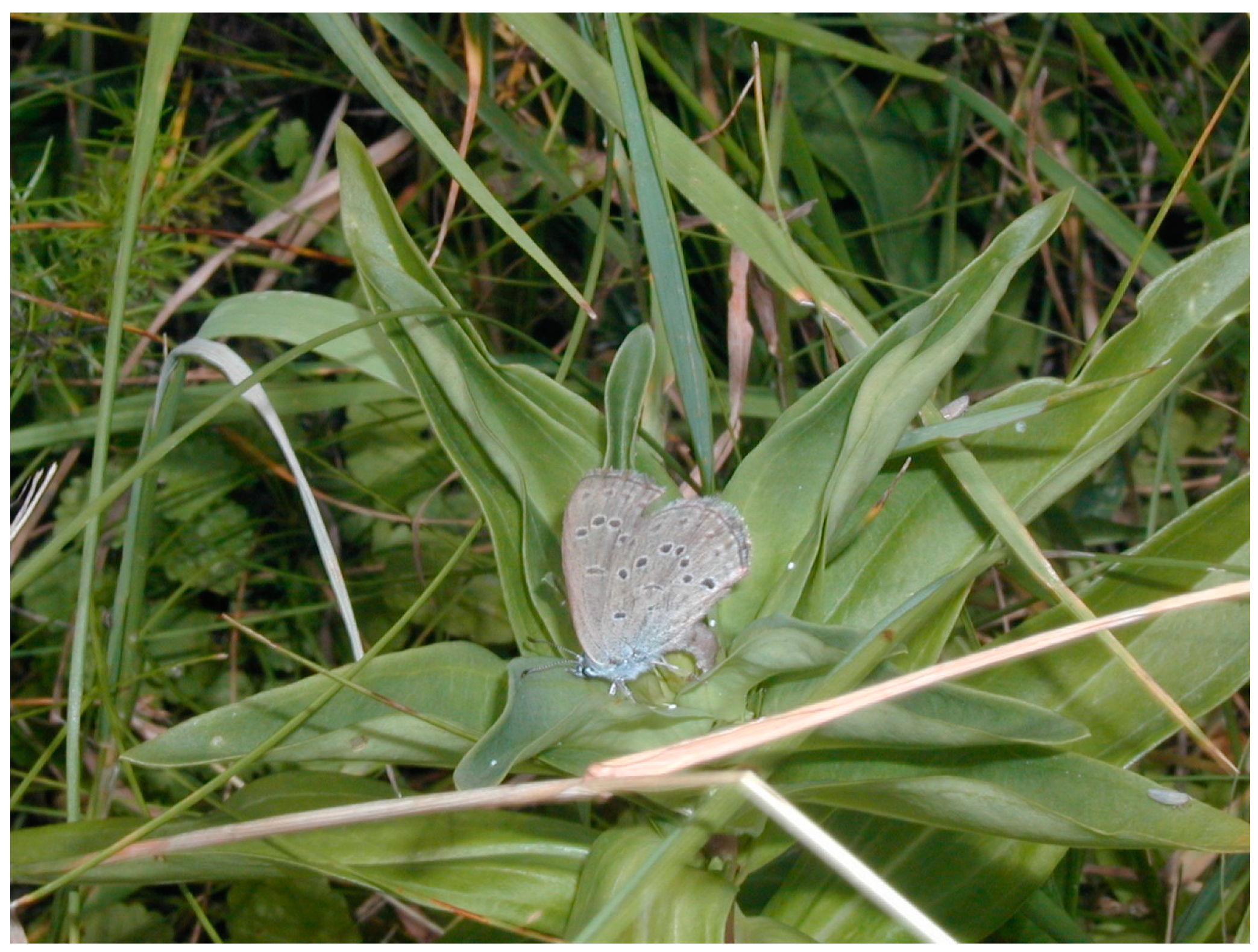
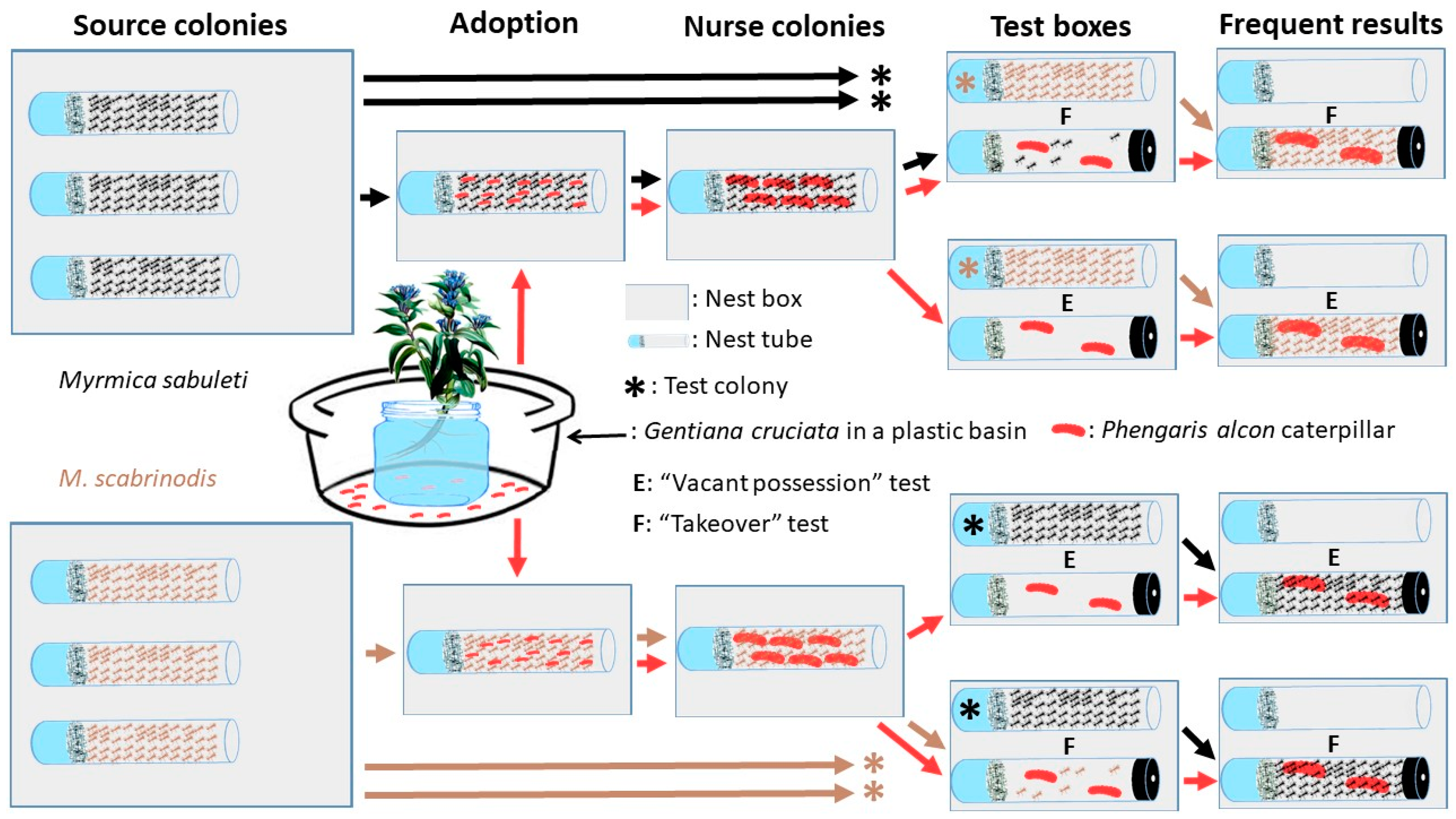
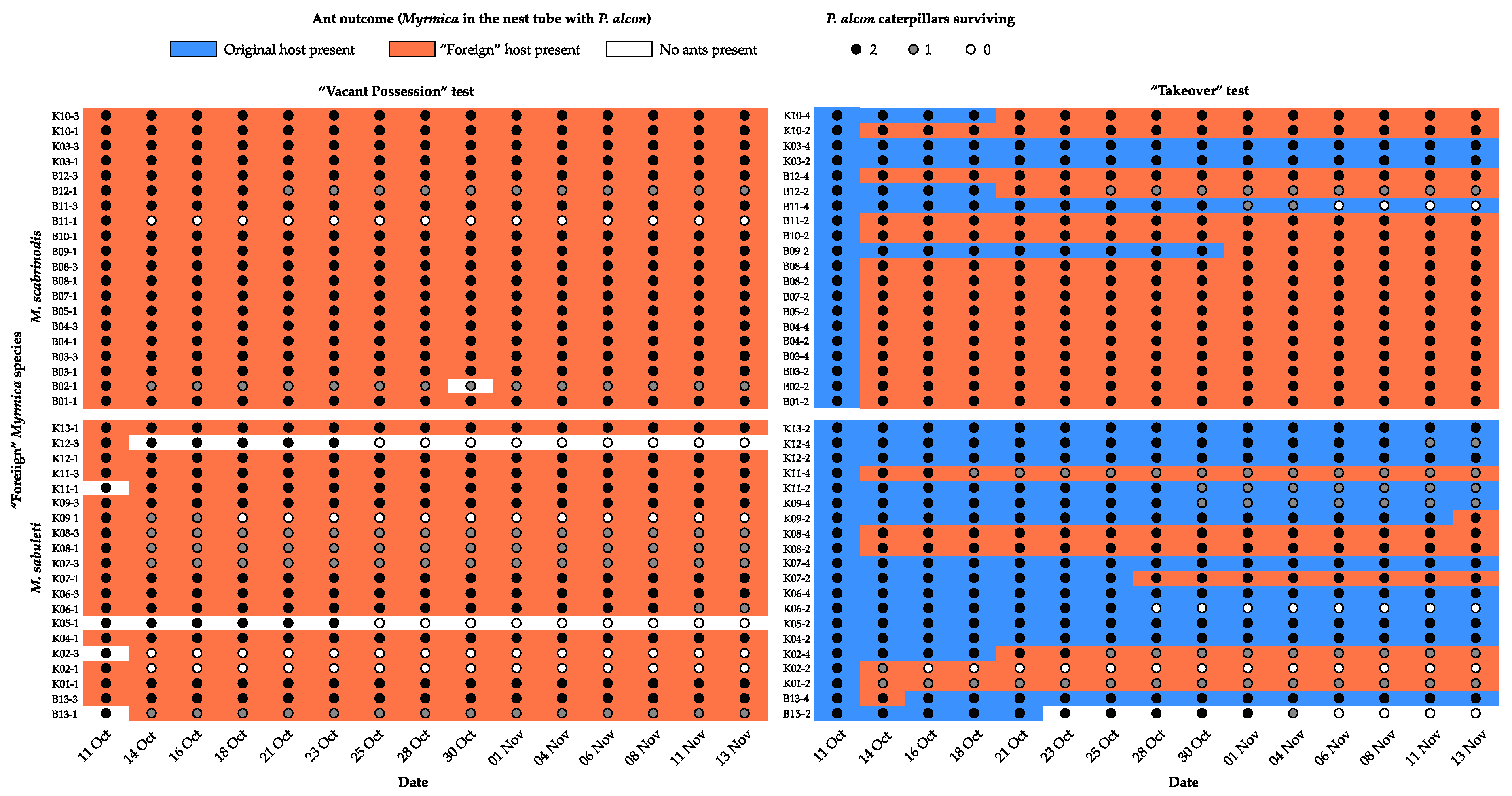
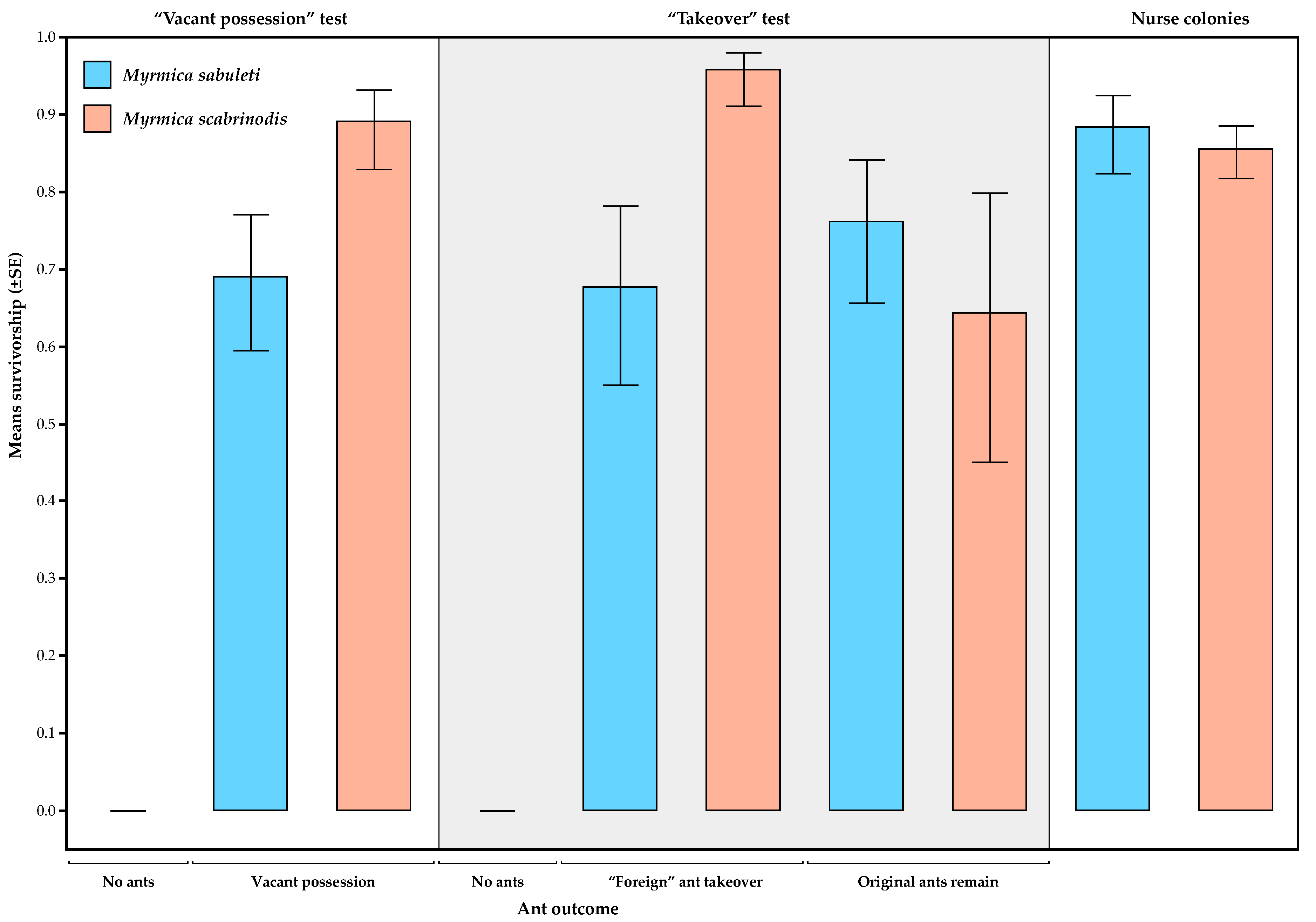
| Number of P. alcon Caterpillars | ||||
|---|---|---|---|---|
| Myrmica sp. | Colony ID | Introduced | Alive | Remaining |
| sabuleti | B13 | 18 | 12 | 4 |
| K1 | 13 | 10 | 6 | |
| K2 | 14 | 12 | 4 | |
| K4 | 14 | 13 | 9 | |
| K5 | 13 | 9 | 5 | |
| K6 | 12 | 9 | 1 | |
| K7 | 12 | 12 | 4 | |
| K8 | 16 | 9 | 1 | |
| K9 | 15 | 10 | 2 | |
| K11 | 20 | 10 | 2 | |
| K12 | 13 | 9 | 1 | |
| K13 | 13 | 11 | 7 | |
| Total | 173 | 126 | 46 | |
| scabrinodis | B1 | 12 | 7 | 3 |
| B2 | 13 | 4 | 0 | |
| B3 | 14 | 8 | 0 | |
| B4 | 14 | 8 | 0 | |
| B5 | 12 | 4 | 0 | |
| B6 | 15 | 0 | 0 | |
| B7 | 13 | 5 | 1 | |
| B8 | 12 | 11 | 3 | |
| B9 | 15 | 7 | 3 | |
| B10 | 14 | 7 | 3 | |
| B11 | 16 | 8 | 0 | |
| B12 | 16 | 9 | 1 | |
| K3 | 15 | 9 | 1 | |
| K10 | 13 | 11 | 3 | |
| Total | 194 | 98 | 18 | |
| Source of Variation | DF | L-R χ2 | p |
|---|---|---|---|
| Foreign ant species | 1 | 6.904 | 0.0086 |
| Test | 1 | 0.007 | 0.9337 |
| Ant outcome [Nested in Test] | 1 | 2.546 | 0.1106 |
| Foreign ant species × Test | 1 | 0.083 | 0.7738 |
| Foreign ant species × Ant outcome [Nested in Test] | 1 | 4.726 | 0.0297 |
| Source of Variation | DF | L-R χ2 | p |
|---|---|---|---|
| Myrmica sp. | 1 | 14.64 | <0.0001 |
| Test | 2 | 6.53 | 0.0382 |
| Myrmica sp. × Test | 2 | 1.86 | 0.3951 |
© 2020 by the authors. Licensee MDPI, Basel, Switzerland. This article is an open access article distributed under the terms and conditions of the Creative Commons Attribution (CC BY) license (http://creativecommons.org/licenses/by/4.0/).
Share and Cite
Tartally, A.; Somogyi, A.Á.; Révész, T.; Nash, D.R. Host Ant Change of a Socially Parasitic Butterfly (Phengaris alcon) through Host Nest Take-Over. Insects 2020, 11, 556. https://doi.org/10.3390/insects11090556
Tartally A, Somogyi AÁ, Révész T, Nash DR. Host Ant Change of a Socially Parasitic Butterfly (Phengaris alcon) through Host Nest Take-Over. Insects. 2020; 11(9):556. https://doi.org/10.3390/insects11090556
Chicago/Turabian StyleTartally, András, Anna Ágnes Somogyi, Tamás Révész, and David R. Nash. 2020. "Host Ant Change of a Socially Parasitic Butterfly (Phengaris alcon) through Host Nest Take-Over" Insects 11, no. 9: 556. https://doi.org/10.3390/insects11090556
APA StyleTartally, A., Somogyi, A. Á., Révész, T., & Nash, D. R. (2020). Host Ant Change of a Socially Parasitic Butterfly (Phengaris alcon) through Host Nest Take-Over. Insects, 11(9), 556. https://doi.org/10.3390/insects11090556





